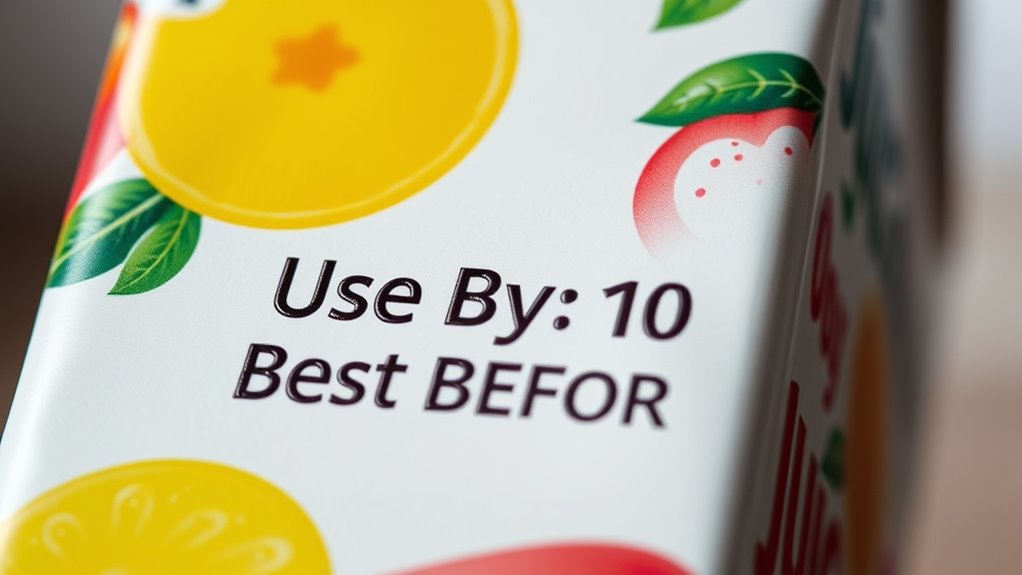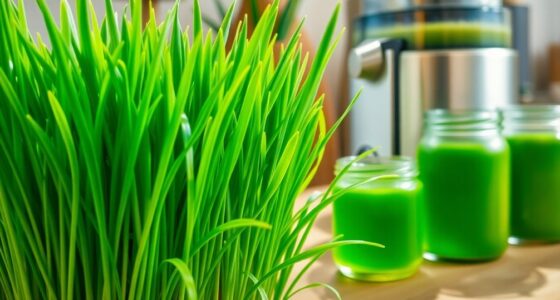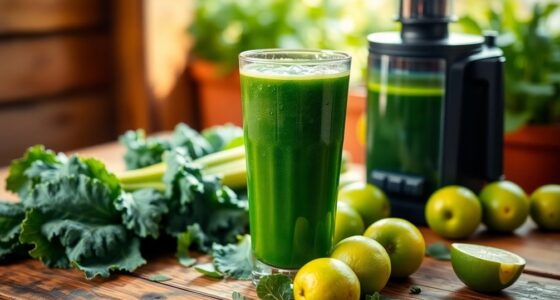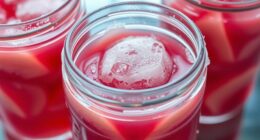‘Use By’ dates show when the juice may no longer be safe to drink, while ‘Best Before’ indicates when the flavor and quality might start to decline. You should always check these labels and follow storage guidelines, like refrigeration after opening, to stay safe. If you notice signs of spoilage, discard it regardless of the date. For tips on preserving freshness and safety, continue exploring this important topic.
Key Takeaways
- ‘Use By’ dates guarantee safety and peak quality; after this, juice may still be safe but quality declines.
- ‘Best Before’ indicates the optimal flavor and texture; consumption after may be less tasty but still safe if no spoilage signs.
- Proper storage—cool, dark place before opening and refrigeration after—extends juice’s freshness and safety.
- Signs of spoilage include off-odor, strange taste, discoloration, or mold; discard if these appear regardless of date.
- Always check labels and storage conditions to ensure juice remains safe and at its best quality.
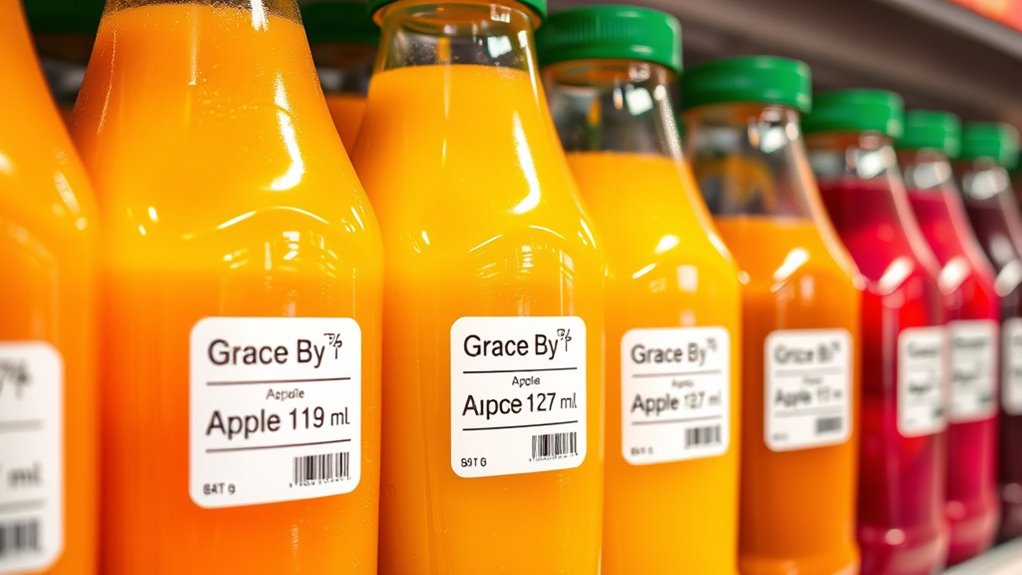
Have you ever wondered what the difference is between “Use By” and “Best Before” dates on juice bottles? Understanding these labels is essential for ensuring your juice stays fresh and safe to drink. The “Use By” date indicates the last day the manufacturer guarantees the product’s safety and peak quality. After this date, the juice might not necessarily be harmful, but its taste, texture, and nutritional value could decline. Conversely, the “Best Before” date suggests the period during which the juice maintains its best flavor and quality. Once past this date, the juice may still be safe to consume, but it might not taste as good or have the same texture. Proper storage practices help extend the shelf life of your juice, ensuring it remains safe and enjoyable to drink. Knowing the shelf life of your juice helps you make better decisions about when to consume it. Proper storage plays a key role in extending this shelf life. Typically, unopened juice should be stored in a cool, dark place like a pantry or cupboard, away from direct sunlight or heat sources. Once opened, however, refrigeration becomes essential. Keeping the juice in the fridge at the right temperature slows down the growth of bacteria and molds, which can spoil the product faster. A good storage tip is to always keep the bottle tightly sealed after each use to prevent oxidation and contamination. This not only preserves the flavor but also prolongs the juice’s freshness. Additionally, cold storage is crucial for maintaining quality after opening. Pay attention to any changes in color, smell, or taste, especially if the juice has passed its “Best Before” date. These signs can indicate spoilage, even if the “Use By” date hasn’t been reached yet. If the juice develops an off-odor, strange flavor, or visible mold, it’s best to discard it. Remember, while many juices have a relatively long shelf life, they are perishable products that require proper handling to stay safe and delicious.
Frequently Asked Questions
Can Juice Be Safely Consumed After the ‘Use By’ Date?
You shouldn’t consume juice after the ‘use by’ date because it may have undergone juice fermentation or microbial growth, which can make you sick. The date indicates when the product is safest to enjoy, as after that, bacteria or mold could develop, especially if the juice has been improperly stored. To stay safe, always check for signs of spoilage and discard juice past its ‘use by’ date.
How Do Storage Conditions Affect Juice Shelf Life?
You can extend your juice’s shelf life by maintaining proper storage conditions. Keep it at a consistent, cool storage temperature, ideally in the fridge, to slow down spoilage. Also, make certain the packaging remains intact; any damages can expose the juice to air and contaminants, reducing its freshness and safety. Proper storage helps preserve flavor, nutrients, and prevents the growth of bacteria, keeping your juice fresh longer.
Are ‘Best Before’ Dates Accurate Indicators of Juice Safety?
Think of ‘Best Before’ dates as gentle guides, like a lighthouse warning sailors of changing tides. They indicate shelf stability and potential quality degradation, but aren’t strict safety cutoffs. You might find juice still safe to drink past that date, though its taste or nutrients could have diminished. Always check for signs of spoilage, such as off smells or appearance, rather than relying solely on the date.
What Signs Indicate Juice Has Gone Bad?
You’ll notice juice has gone bad if it develops fermentation signs, like a fizzy or sour smell, or changes in taste. Mold development on the surface or inside the bottle is a clear sign it’s spoiled. Also, if the juice appears cloudy, thickened, or has an unusual color, it’s best to discard it. Trust your senses—if anything seems off, don’t risk drinking it.
Do Organic Juices Have Different Date Labels Than Regular Juices?
Organic juices often have different date labels because of their organic labeling and juice certification standards. You’ll notice labels like ‘Organic Best Before’ or specific certifications indicating organic quality. These labels help you recognize that the juice meets strict organic guidelines, which may influence shelf life. Always check both the date and certification labels to make certain you’re consuming authentic organic juice before it expires, maintaining freshness and quality.
Conclusion
Remember, ‘Use By’ tells you when juice is safest to drink, while ‘Best Before’ shows when it’s at its best quality. Pay attention to these dates to keep your health safe, your taste buds happy, and your experience enjoyable. Respect the labels, check the dates, and make smart choices. Because understanding these labels isn’t just about the juice—it’s about caring for yourself, making informed decisions, and enjoying your beverages at their best.
Cindy thoroughly researches juicing trends, techniques, and recipes to provide readers with practical advice and inspiration. Her writing style is accessible, engaging, and designed to make complex concepts easy to understand. Cindy’s dedication to promoting the advantages of juicing shines through her work, empowering readers to make positive changes in their lives through the simple act of juicing.

